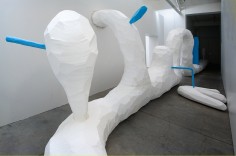Peter Robinson
source: emmanuelherve
Peter Robinson (born in 1966 in Ashburton, New Zealand) studied sculpture at Ilam School of Fine Arts (1985-1989), and now lives and works in Auckland. Robinson is an important figure in the wave of second generation Mãori artists that emerged in the late eighties from the School of Fine Arts (Ilam) at the University of Canterbury, Christchurch, New Zealand. Well known in New Zealand for dealing with issues such as race relations in a provocative and controversial manner, Peter Robinson’s practice has been characterised by elements of shock and surprise. He has continually shifted tack throughout his career in his use of materials and techniques and the content he addresses.
His work seems to exist in a constant state of flux and change and his subject matter also appears to swing between an articulation of intellectual ideas and pop culture but certain forms and ideas run through his practice. Originally trained as a sculptor, he has also worked in painting, drawing, installation and digital media. His style has varied from rough hand written text on placards to the slick, clean aesthetic of digital prints.
Robinson’s early works were concerned with personal and racial issues as he analysed and responded to his part-Maori heritage. He used painting and sculpture to wittily critique assumed aspects of bi-culturalism, the branding of ethnicity, and careerist strategizing – while simultaneously embracing them. He created a series known as the Percentage Paintings in the early 1990s that discussed his specific racial make-up. The works posed the question to the viewer ? should a percentage of Maori blood determine his personal and social character, and his importance as an artist? He found that art critics began to stereotype him as a Maori artist but that personally he was not able to work in traditional Maori forms because this felt ‘inauthentic’. Recognising this he changed direction and shocked art critics by adopting both Pakeha (non-Maori) and Maori voices often in a contradictory way. From this bi-cultural perspective Robinson could incisively comment on the complexities of race relations, both historical and contemporary, in New Zealand.
More recently, Robinson has shifted from this rhetoric and weight of interpretation to focus more exclusively on exploring and celebrating the materiality of the mediums with which he works such as felt, polystyrene, and steel. Interested in the play between order and disorder, density and lightness, dispersion and compression, Robinson creates bold, monumental and irrepressible forms where the idea of sculpture is often momentarily balanced between building up and breaking down. Indeed, Robinson’s affection for materiality is regularly experienced as profusion and excess.
Robinson’s work has been exhibited extensively in New Zealand and internationally. He was New Zealand’s representative at the 49th Venice Biennale (2001), participated in the 13th Istanbul Biennale (2013), 11th and 18th Biennale of Sydney (1998/2012), and the 8th Baltic Triennale of International Art, Vilnius (2002). His work has been included in major international touring exhibitions including: Continental shift, Ludwig Forum für Internationale Kunst, Aachen (2000); Toi Toi Toi: three generations of artists from New Zealand, Museum Fridericianum, Kassel (1999); and Cultural safety: contemporary art from New Zealand, Frankfurter Kunstverein, Frankfurt am Main (1995). Robinson was nominated for the Walters Prize in 2006 for The Humours at Dunedin Public Art Gallery, and again in 2008 when he won for his exhibition ACK at Artspace, Auckland.
.
.
.
.
.
.
.
source: peterrobinson
Peter Robinson employs polystyrene to investigate the gallery as site. Scale is manipulated, presenting contradictions in weight and strength which often have the effect of destabilising the viewer’s sense of perception. The works are often massive and require teams of people working together to physically structure the work and solve problems, creating a sense of community.
Artist Statement
For some time now, I’ve been working through a love-hate relationship with minimalism and various forms of its mannerist and populist legacies. I love its po-faced assertions of egalitarian values – it’s weird hovering between a steel-fronted refusal of politicised content, and an oblique pitch for radical political valence. I find the fierce attention to conditions of material existence and perceptual behaviours – which much minimalist practice tried unsuccessfully to fix through formal rigour – freshly relevant in our so-called digital age. We are more than ever impelled to think about material conditions, modes of organisation, systems of knowledge, and how we can make sense of them in ways that have relevance beyond the ‘merely formal’. What do we do with all the stuff we have, that we produce, that others lack? My use of polystyrene over the last few years has been a somewhat self-parodying, self-defeating enterprise as it is a material that, while carrying associations of environmental degradation, seems truly invented for fabricating corruptible artifices, brittle fantasies, luminous delusions. Its industrial neutrality is fraught with a sense of massive inauthenticity that touches on the triviality of the instantly disposable and and the sheer absurdity of our contaminated idealisms.


